
Casuarina is a genus of 17 tree species in the family Casuarinaceae, native to Australia, the Indian subcontinent, southeast Asia, islands of the western Pacific Ocean, and eastern Africa. It was once treated as the sole genus in the family, but has been split into four genera.

Ehrharta is a genus of plants in the grass family.
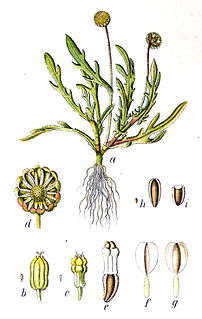
The small marsh flower Cotula coronopifolia bears the common names brass buttons, golden buttons, and buttonweed. The flower heads are bright yellow discoid heads that look like thick buttons. Individual plants spread stems along the ground and send up the knobby flowers at intervals. The plant is native to southern Africa, as well as New Zealand, but it has been introduced to other parts of the world.
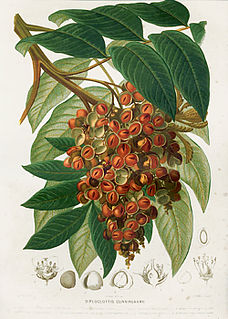
Diploglottis is a genus of 10 species of trees known to science, constituting part of the plant family Sapindaceae. They grow naturally in rainforests and margins of adjoining humid forests in eastern Australia and New Guinea. Some species are known as native tamarind or small-leaved tamarind; they have no direct relationship with the true tamarind.
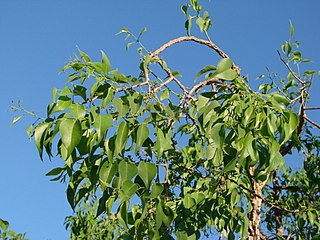
Agonandra is a genus of plants in the family Opiliaceae described as a genus in 1862.

Dimorphotheca sinuata, the glandular Cape marigold, Namaqualand daisy, or orange Namaqualand daisy; syn. Dimorphotheca aurantiaca hort.) is an African species of plants native to southern Africa. It is also widely cultivated as an ornamental and naturalized in parts of the United States, primarily California and Arizona.

Cyanotis is a genus of mainly perennial plants in the family Commelinaceae, first described in 1825. It is native to Africa, southern Asia, and northern Australia.
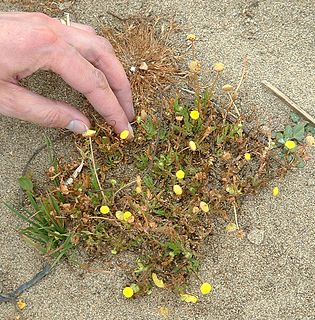
Cotula is a genus of flowering plant in the sunflower family. It includes plants known generally as water buttons or buttonweeds.

Stackhousia is a genus of annual and perennial plants in the family Celastraceae that are native to Australia, New Zealand, Malesia and Micronesia. The genus was first described by James Edward Smith in Transactions of the Linnean Society of London in 1798.

Senecio angulatus, also known as creeping groundsel and sometimes as Cape ivy, is a succulent plant from the family Asteraceae of the genus Senecio that is native to South Africa. It is a scrambling and a twining herb that can become an aggressive weed once established, making it an invasive species in some countries. However, it is grown as an ornamental plant for its satiny foliage and sweet-scented flowers.
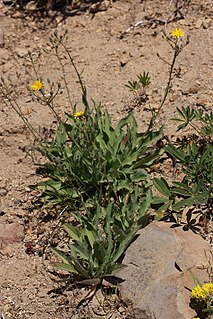
Pilosella scouleri is a North American species of flowering plant in the dandelion tribe within the sunflower family. It is known as Scouler's woollyweed. It is native to western North America, from British Columbia and Alberta in Canada, south to northern California and Utah in the United States.

Araujia is a small genus of perennial vines in the dogbane family first described as a genus in 1817. The group is native to South America.
- Araujia angustifolia(Hook. & Arn.) Steud. - Brazil, Paraguay, Uruguay, NE Argentina
- Araujia graveolens(Lindl.) Mast. - Brazil
- Araujia herzogii(Schltr.) Fontella & Goyder - Bolivia
- Araujia hortorumE.Fourn. - Brazil, Paraguay, Uruguay, NE Argentina
- Araujia megapotamica(Spreng.) G.Don - Brazil, Uruguay, NE Argentina
- Araujia plumosaSchltr. - Brazil, Paraguay, Bolivia, NW Argentina
- Araujia sericiferaBrot. - white bladderflower, cruel vine - Peru, Brazil; naturalized in parts of South Africa + United States
- Araujia stuckertiana(Kurtz ex Heger) Fontella & Goyder - Cordoba in Argentina
- Araujia subhastataE.Fourn. - Brazil

Bidens laevis is a species of flowering plant in the daisy family known by the common names larger bur-marigold and smooth beggarticks. It is native to South America, Mexico, and the southern and eastern United States. It grows in wetlands, including estuaries and riverbanks.
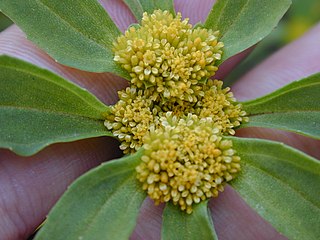
Flaveria trinervia is a species of flowering plant in the aster family known by the common names clustered yellowtops, speedyweed, and yellow twinstem. It is native to parts of the Americas, including the southeastern and southwestern United States, most of the Bahamas, Mexico, Belize, and parts of the Caribbean, especially Cuba, Cayman Islands, Jamaica, Hispaniola, Puerto Rico and Barbados. It is also known in many other places as an introduced species and often a noxious weed, such as in Hawaii.

Arctotis venusta is a species of South African plants in the daisy family. Common names include silver arctotis, kusgousblom, and blue-eyed African daisy. It is native to the western coast of South Africa, The species is widely cultivated as an ornamental, and has become naturalized in parts of the United States, Australia, and Central and South America, where it has escaped from gardens to become a noxious weed.

Bidens bipinnata is a common and widespread species of flowering plant in the daisy family. It is widely dispersed in many lands, so much so that it is difficult to ascertain with certainty its region of origin. It seems most likely, though, that it is native to Asia and North America, and naturalized elsewhere. It is most commonly called by the common name Spanish needles.

Erechtites valerianifolius, common name tropical burnweed is a New World species of plants in the sunflower family. It is native to Mexico, Central America, South America, and the West Indies. It is also naturalized as a weed in much of the tropical Old World.
The Flora of Fuegia, the Falkland Islands, etc. is a description of the plants discovered in these islands during the Ross expedition written by Joseph Dalton Hooker and published by Reeve Brothers in London between 1845 and 1847. Hooker sailed on HMS Erebus as assistant surgeon. It was the second in a series of four Floras in the Flora Antarctica, the others being the Flora of Lord Auckland and Campbell's Islands (1843-1845), the Flora Novae-Zelandiae (1851–53), and the Flora Tasmaniae (1853–59). They were "splendidly" illustrated by Walter Hood Fitch.

The Flora of Lord Auckland and Campbell's Islands is a description of the plants discovered in those islands during the Ross expedition written by Joseph Dalton Hooker and published by Reeve Brothers in London between 1843 and 1845. Hooker sailed on HMS Erebus as assistant surgeon. It was the first in a series of four Floras in the Flora Antarctica, the others being the Flora of Fuegia, the Falklands, Kerguellen's land, etc (1845–1847), the Flora Novae-Zelandiae (1851–53), and the Flora Tasmaniae (1853–59). They were "splendidly" illustrated by Walter Hood Fitch.


















